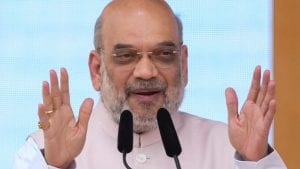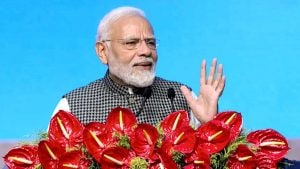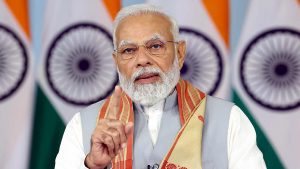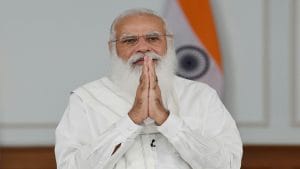9 Years of Modi government | India needs to focus on reigniting private capital and investment, says former VC of NITI Aayog

KV Prasad Jun 13, 2022, 06:35 AM IST (Published)
 Listen to the Article (6 Minutes)
Listen to the Article (6 Minutes)
Summary
Former NITI Aayog vice-chairman Rajiv Kumar feels India’s biggest priority must be to reignite the private capital and this can be done with better efforts to make our exports globally competitive.
The Narendra Modi government is completing 9 years in power. The country currently ranks among the fastest growing economies in the world, especially in the post-pandemic era.
In January 2023, the Reserve Bank of India (RBI) said India would become a $3.7 trillion economy by the end of 2023, maintaining its lead over the United Kingdom (UK) as the fifth largest economy of the world. The government aspires to make India a $5 trillion economy by FY27.
So here’s a look at some of the key economic parameters and how they have moved in the last 9 years.
Inflation, which has been a concern off late prompted the RBI to hike rates rather sharply. After holding rates steady at 4 percent for over 23 months, the RBI implemented rapid rate hikes, taking repo rate to 6.5 percent in a span of just 10 months. But even now, repo rates are lower than the 8 percent levels seen in early 2014.
Inflation itself is also much lower than it was 9 years ago. From a peak of above 11 percent in late 2013, retail inflation or CPI inflation dropped to a low of around 2 percent. It has not gone back above 8 percent since, despite a sharp rise in late-2019 and for the better part of 2020. As India and the rest of the world battled a global pandemic and the Russia-Ukraine war whose rumblings started in late-January 2022, sparked another spike in inflation, but this was not unique to India.
Since September 2022, inflation has been slipping, in keeping with the RBI’s rate hikes and at the last reading stood at an 18-month low of 4.7 percent. The RBI says it is poised to act with more rate hikes, should external factors warrant further rate action.
India’s GDP, in absolute terms, has also grown over the period. From a little over $2 trillion dollars in 2014, it is estimated to hit $3.73 trillion by 2023-end.
Growth rate, however, has been far from steady. From 8.2 percent growth in FY16, the growth rate slipped steadily to 4.5 percent in FY19 and 3.7 percent in FY20… even contracting by 6.6 percent in FY21. Of course, these three years were also the years when the economy felt the strain of pandemic-related lockdowns, freezing nearly all economic activity in the country.
The India story was not lost on the rest of the world. Foreign direct investment (FDI) into India jumped from $36 billion in FY14 to $45 billion in FY15. FDI inflows spiked up to over $83 billion in FY22.
But there are concerns as well. In May 2019, the government’s labour department confirmed that India’s unemployment had peaked to a 45-year high. The data released by labour ministry showed 7.8 percent of all employable urban youth being jobless, while the percentage for the rural was 5.3 percent. As per the latest data released by the ministry of statistics and programme implementation, India’s urban unemployment rate stood at 6.8 percent in the January-March 2023 quarter.
Now to private capex. Fitch has said that corporates are likely to see an uptick of 10 to 12 percent in FY24; however, they may run into external risks and higher interest rates.
In an interaction with CNBC-TV18, Rajiv Kumar, Former Vice Chairman of NITI Aayog stated that focus of the government on structural reforms in difficult areas like GST, Insolvency and Bankruptcy Code and reduction of the corporate tax rate were crucial in the past nine years.
He highlighted that going ahead the government needs to reignite the private capital and investment.
Also Read: As Modi government completes 9 years, a look at his current approval rating
According to Rathin Roy, Managing Director of Overseas Development Institute, all the reforms undertaken and completed by the Modi government have been valuable but inequality and inclusion still remain a challenge for the government.
Below are the excerpts from the interview.
Q: As we look at a decade now in office, and more importantly, what the road ahead should look like, what would you say have been the big highlights where you feel satisfied with the work done, but more importantly, the priorities that the government needs to focus on going forward?
Kumar: For me, the big highlight of the nine years, there are a few. One is the focus on structural reforms which have been undertaken in very difficult areas, like the implementation of the GST, the Insolvency and Bankruptcy Code, reduction of the corporate tax rate, the sort of focus on the underprivileged by giving them all sorts of schemes, but also at the same time retaining fiscal stability, being fiscally prudent and not letting the debt to GDP ratio go out of kilter, at the same time, making sure that India story remains a very positive story for the rest of the world especially when the corporate global world is de-risking itself.
Going forward, I think the biggest priority in my view must be to reignite the private capital, private investment story, to get that going in a much bigger way. It’s already started. I’m glad to see that the credit growth from the commercial banks has now picked up and is now in double digits. But this has to be raised much further if we want to achieve the rate of growth that we want to achieve.
Now it’s very good to say that we are the fastest growing large economy in the world. I think that deserves all the all the compliments that it does, but also, I would want to emphasise that we need to go beyond our 7 percent or 8 percent rate of growth that we had achieved in the past. So for me, the single most important part is to create the environment for a much bigger investment appetite for the private sector in this economy and to make room for them by moving out of sectors as the government has promised, except the five critical sectors, and evolving a new model of private public partnership, where private execution of public ideas or public policies should be the norm going forward.
Q: Your own assessment of what you believe have been the meaningful measures taken by the government over the last nine years? But importantly, to the point that’s been raised by Rajiv Kumar, we are finally starting to see private capex return to some extent. In the words of the chief economic adviser incipient signs of private capex picking up. The hope is that we will continue to see this through the course of FY24. But to be fair to the government, they have done what they could. They have cut corporate tax rates that happened pre-pandemic, then we had to deal with two or three years of the pandemic. There have been other measures announced by the government including PLI schemes and so on and so forth, as well. So can the government really do more outside of the other point that he made on disinvestment and asset monetisation, to really unleash the appetite of the private sector?
Roy: I think all the reforms that Rajiv mentioned that have been commenced by the previous government, and completed and finished by the Modi government are valuable reforms. They also reflected until about 2016, the sort of spirit of bipartisanship regarding the priorities in the economy. After that I think we have seen certain challenges. First, the health of the fisc has begun to deteriorate and the impact of that has been twofold. One, the government has not been able to collect revenues, that would reflect the buoyancy you would expect in a growing economy. And it has had to compensate for that not by spending less, but also by taking away from the states. So if you look at India as a whole, what the central government has done, because of this phenomenon has happened to some extent at the expense of the states. And this needs to be righted going forward. That’s the first challenge.
The second challenge, of course, is growth. And I have to be honest, if I ask the government of India, what do you think India’s growth rate will be in 2026? I have no clue. There is no official estimate. There are figures put out about trillion dollar economies, but I don’t have a growth rate and I don’t know what the structure of that growth is going to be. Is it going to come from manufacturing, is it going to come from agriculture? So what I don’t see is a forward plan and that in a current situation where growth is extraordinarily tepid, I think is worrisome.
The third problem which is the most important problem this government will have to confront, is inequality. In almost every dimension, you see economic inequality on the rise. The government intervenes through various schemes, direct benefit transfers, etc. But those interventions do not solve for the problem, that our growth process itself is not inclusive. And so then what happens is the government spends all its money, essentially on compensating people. You didn’t get development, you were not included in the growth process, here’s a compensation. This unequalising growth spiral has to stop. It’s not just unequalising between the rich and the not so rich, it’s also a very unequal legacy they have inherited in this country. In terms of regional inequality, Uttar Pradesh is poorer than Nepal, Tamil Nadu is as rich as Indonesia. Tamil Nadu has eliminated poverty, its human development numbers, therefore are better. However the political power vests with Uttar Pradesh which is naturally more populous. So this is going to be a big road bump going ahead, and the government better watch out that it does not disrupt the political economy that would allow for stable and inclusive growth in the country. So I would say my number one priority for this government, any government that wins the next election going forward is inclusion, inclusion inclusion.
Q: Rathin Roy said that whatever is being done should not come at the expense of the states. Now, this has been a cause of concern, especially with the advent of the GST, and then the sun setting on the GST compensation that states were availing off. More importantly, there have been concerns on devolution with the 15th Finance Commission’s formula, expectations are that we could see some change on that front as well. How would you like to proceed on this front especially given the concerns that have been raised by states in a GST era?
Kumar: I think it is critical to work with the states. All of the action is actually now in states and not in Delhi and I have been saying this ever since I have been in NITI Aayog and otherwise. The government has actually started to do that, which is to setup state level NITI Aayogs and for them to draw the development blueprint for each state, because each state of ours is a unique economic entity in its own right and very, very large too.
What Rathin has said is right, the difference between Goa and Bihar, in per capita incomes is 10:1 and this is just not sustainable because we can’t continue, we can’t afford the sort of growth story that we have, which means a huge migration from the north and the east, to the south and the west, because that simply can’t go on.
But the thing is that the 15th Finance Commission, whose recommendations this government implemented right away, had increased the devolution of the tax revenues, etc. to I think 42 percent from the earlier 30-31 percent something like that, so that has already been done. What you need now to do is to work with the states to ensure that their capital expenditure on infrastructure, on the facilities, the poor, on the delivery of goods and services for those at the bottom of the pyramid are all much better than what they have been before.
But the second point that I would like to make and what Rathin said about inclusion — Rs 28.5 lakh crore has been transferred through direct benefits to the underprivileged, that’s a huge amount. About 460 million bank accounts being opened to facilitate that. Then you have the Ujjwala Yojana and the Awas Yojana — 110 million households of the total 180 or 190 million rural households have got the gas cylinders — these have huge impacts at the bottom of the pyramid.
In fact, when I presented the multi-dimensional poverty impact report in the UN General Assembly, a couple of years ago, there was universal appreciation of the fact that India had been able to positively impact more than 400 million people to do better and come out of the multi-dimensional poverty. Same is true about the Ayushman Bharat Yojana and the Jan Aushadhi. So all of these are real improvements in the life of the people.
So per capita income is not the only measure for improving the welfare levels of the people. I think all of these contribute to that, and I think there the government has done exceptionally well, because it has improved the efficiency of the distribution of public goods and services and raised that bar much higher than what it had inherited from past.
Q: If I were to ask you to prioritise, what next you would like to see as the government intervenes? We are hoping that growth will take care of some of these challenges and some of these concerns, but where would you like the government now to intervene? What kind of measures would you like to see?
Roy: In the long term, we cannot subsidise the majority of our population in perpetuity — that is a failed growth model. It’s a good thing that the government is ameliorating essentially what is a massive market failure in the northern eastern areas of our country, principally, because people there are too indigent and earn too little to do what you and I do, which is go to the market, buy a gas cylinder, and afford to buy gasoline, go to a bank, get an EMI, build a house and afford to build a house.
Far too many people outside the top 150 million-200 million people are unable to engage as participants in the market. And in the long term, our growth has to be such that those people are able to engage and go to the market and buy the things that they want. So we need growth, but we need growth, that is able to satisfy at affordable prices without subsidy in the medium term.
Then let’s say what the top 40 percent of the population want? They want what everybody wants, they want more things. They want air conditioners, private cars, they want to get a square meal, they want to buy Rs 200 shirt, they want to get an affordable house by going to the bank and getting a loan, they want good quality healthcare, good quality education. I am now speaking of all of India — state and Centre. None of these goods that I mentioned to you are being provided to them through the market. Agriculture is subsidised and cross subsidised to death. The shirt, I am wearing costs Rs 3,000, it is made in India. Rs 200-300 shirts, the bulk of them are imported from Bangladesh and Vietnam.
Housing also requires subsidy. So we have to come up with a model where these houses are affordable. Healthcare, again, the government is subsidising healthcare, and that’s a good thing. But we do need to come up with a better, more affordable model. And education needs to be fixed, it is pretty bad.
So I would say the government could say that about two-thirds of the growth going forward, will come from these five areas — home-market demand, about 20 percent more from exports and 20 percent from the stuff we consume, which is the bulk of our growth today — air conditioners, air travel, that sort of thing, then we will be on the path to sustainable, inclusive, market driven, transformative, prosperous growth across regions of India. So I think that is the next challenge, the next government will have to take up and I will be advocating for it and writing about it from now till the next government, whichever it might be takes office.
Q: You have been a big advocate in terms of the export story we have seen pickup in exports, of course, currently, because of the external environment, there has been a slowdown. But on exports outside of the measures taken by the PLI schemes, some of the FTAs, which continue to be work in progress, a few comprehensive economic partnership agreement (CEPA’s) that have been inked, what more would you like to see, to really unleash that aspiration and ensure that we really do get to our potential in this environment of de-risking of supply chains, and so on and so forth?
Kumar: I have been an advocate of export expansion, exports speeding up, etc. as one point answer to many of our problems. But let me just say, two or three things before I come to the specific measures. One, the slowdown in global economy should not be used as any reason for a slowdown in our exports. This is the time when we can expand our exports and should try and expand the share in global markets, grab a greater market share, rather than increase our exports only when the going is good. Because that is what we have done in the past, that is just simply not good enough. We have got to act now. That is the first thing.
The second point is that all our export industries, except for petroleum exports, which I shouldn’t actually even count as a part of our exports — and this is what the government should do, which is to put out data. We always say export minus oil export, all the rest are labour intensive industries, which means that they generate employment, skilled employment in different parts of the country and that is the second big plus point where exports need to go.
And the third thing about exports is that exports can be diversified across all the sectors of the economy.
Coming to this specific issues, I think what I have seen over the years is that we are still not able to work with our private investors, with our entrepreneurs, with our startups, to de-bottleneck the sort of issues that have come about. And this requires a very strong and a very consistent partnership between the central, state and local government. Because those are where the problems are. If you talk to the exporter, they will tell you that the problem is not in the policy as much as getting some license or change in land use etc. So that is the first issue that we need much better way of working, based on mutual trust between the entities that are involved in exports.
The second point is that our small and medium enterprises are still localised, they have not been able to become part of the global or regional production chain. Now we must go there, we should not in some sense, exult in the fact that our local enterprises have been given so many millions of Mudra loans because they are not going to make us export competitive. So therefore, that is the second part. I think we need a special effort on that to make our small and medium enterprises globally competitive. What is to be done there? How do we organise that?
The third part about our exports is that we now need to pick some industries, which we think are going to be winners. Now the PLI scheme is all very well, but I am afraid it’s now become so dissipated and it’s spread across so many large sectors, that we are not taking a bet. Every country which has raised its market share has taken a bet on few of the rising sectors of the global economy. We want to do this, we will capture the market going forward in this and this sector or sectors which you see are rising. Those bets have to be taken and those bets have to be taken in a manner where the government and the private entrepreneur and the companies work together, agree on that bet and then execute and implement them.
Roy: I want to say two things. One, I agree with everything that Rajiv said. Exports would be a very good idea. And 70 years after independence, we are sitting with a share of global exports of less than 2 percent. The second thing I want to say is, a society that has turned on itself and displays conspicuous violence within its borders, and displays sort of like competitive violence within groups of people, whether it is caste, ethnicity religion, has never in the history of the world, been a successful transformative economy.
Q: Physical infrastructure or digital infrastructure, which do you believe has been the bigger success story of this government, because they have prioritised both?
Kumar: Both are big successes and even connectivity. This government has taken amazing steps in improving connectivity in the economy. And that connectivity is completely class-, sector- or regiment-agnostic and therefore has helped everybody. But let me just say one thing, which is that I think we now need to have a different approach towards public private partnership. We’ve got to start building the trust between the different stakeholders, and stop looking for those who are not doing the things they want to do. But look out for those who are doing the right things and emulate them. This is I think, going to be the key, especially if you want to improve your shares in global markets. You have to do it in a much more collaborative manner than you have done.
Roy: I agree with Rajiv. You have to go easy on Enforcement Directorate (ED) and PMLA and raid raj. Trust your people. The vast majority of Indians are honest, hardworking people. Too much of this enforcement culture actually raises suspicions that it’s being done for political purposes. The less of this divisiveness we have, the faster we will be able to grow together.

Elon Musk forms several ‘X Holdings’ companies to fund potential Twitter buyout
3 Mins Read
Thursday’s filing dispelled some doubts, though Musk still has work to do. He and his advisers will spend the coming days vetting potential investors for the equity portion of his offer, according to people familiar with the matter

KV Prasad Journo follow politics, process in Parliament and US Congress. Former Congressional APSA-Fulbright Fellow



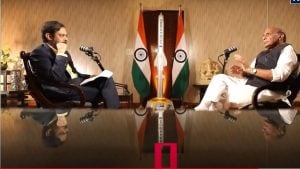






 Listen to the Article
Listen to the Article  Daily Newsletter
Daily Newsletter






